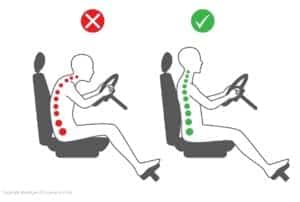Is back pain driving you mad? Do you get out of your car hunched over in agony? Your car seat position and your posture whilst driving could be culprit to your back pain.
Anybody who has spent any length of time driving in a car may well have experienced lower back pain, neck ache and shoulder pain.
Driving exposes the body to many different forces including acceleration, deceleration and vibration which can contribute to back pain. However, it is also the car seat and driving position that can have a big impact on our back health. A recent poll found one in three drivers had to take time off work to recover from back pain problems caused by the chairs in their car, with 1 in 20 having to have at least 5 days off.
The poll carried out by Swedish car manufacturer, Volvo, indicated men are more likely to suffer from back pain caused by their car seat but this may be impacted by the mileage driven, with men averaging 60 miles a day, and women doing half that.
The cost implications of this are huge, not just for the individual with loss of earning but as an economy. Volvo suggests car seat-caused back pain may be costing the health service around £200m every year. It also estimates British businesses are being stung to the tune of £8.8bn per year through lost productivity.
What can we do to avoid back pain from driving?
1) Seat adjustments
Everybody is different, so do make sure you adjust the car seat to suit you if you share a car.
- Start afresh by pushing the seat all the way back and lowering it as far as it will go. Then recline the back of the seat to about 30-40 degrees and move the steering wheel (if it adjusts) all the way up and in towards the dashboard.
- Now, raise the seat up so your hips are as high as your knees and you can see the road and dashboard clearly. Don’t be so high that you need to bend to see. Add an extra cushion to the seat if still too low to get a good view.
- Move the seat forward so you can reach and completely depress all the foot pedals without your back moving away from the back of the seat. Make sure you have a small bend in your knees of at least 20-30 degrees – having your knees too straight can cause knee pain.
- Ensure the backs of your knees do not touch the car seat bottom, as this is bad for your knees and your circulation. There should be at least a two-finger gap between the back of your knee and the seat.
- When it comes to the seat back, raise the inclination to an angle of 100-110 degrees. This angle decreases the pressure on the discs in your low back.

- To provide extra support to the lower back, there are special cushions you can use as often cars don’t come with enough lumbar support. The Original Mckenzie® range are an example of the kind of additional support available which comes in different sizes depending on patient’s weight/and how much lumbar support is need. Alternatively, you could use a small rolled up towel in the curve of your lower back, changing the thickness to suit.
2) Adjust your steering wheel
Once you have the seat in the right position, make sure the steering wheel is at a good distance so you can comfortably hold the wheel with a slight bend in the arms. If the wheel is too far away it will create tension between the shoulders and upper back. Too close, and it will restrict the movement of the wheel and turning, putting extra strain on your wrists and muscles of upper back.
When stationary, your shoulder blades should be able to be pressed back into the chair and when your arm is straight, your wrist should be able to bend over the edge of the steering wheel.
When you’re driving your arm should be bent around 120 degrees.
3) Mirrors
Once the car seat and steering wheel adjusted accordingly, check your mirrors to make sure you can see clearly all you need to. If not, you’ll end up straining to view and moving the head a lot more than is required.
4) Take regular breaks
Sitting in the same position for any length of time will stiffen up your back muscles. Stop for a break to stretch your legs, arms and backs at least every 2 hours – or more regularly if feeling discomfort.
5) Relax
Being tense will put stress on the spine. When you’re relaxed, it allows the chair to take your weight
Our posture, whether it’s driving, sleeping or working at a desk does need to be cared for regularly. Exercise, stretching, appropriate equipment and furniture settings and chiropractic treatments can all help strengthen your muscles and posture to avoid aches and pains.
Our blog on sleeping position offers some top tips on how to get a better night’s sleep and posture.
If you are experiencing back pain, we are a chiropractors in Leeds that can give you expert advice on your posture and seating position, as well as treat the root cause of your pain. Contact us to arrange a free 15 minute health check to discuss your problems and how we can help get you back to happy.


